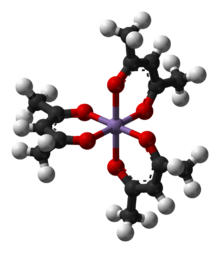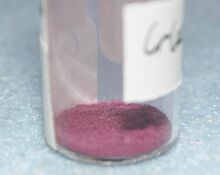Chemistry:Chromium(III) acetylacetonate

| |
 Solid chromium(III) acetylacetonate
| |
| Names | |
|---|---|
| IUPAC name
Tris(acetylacetonato)chromium(III)
| |
| Other names
Tris(2,4-pentanediono)chromium(III), Cr(acac)3, Cr(pd)3
| |
| Identifiers | |
3D model (JSmol)
|
|
| ChEBI | |
| ChemSpider | |
| EC Number |
|
PubChem CID
|
|
| |
| |
| Properties | |
| Cr(C5H7O2)3 | |
| Molar mass | 349.32 |
| Appearance | deep maroon |
| Density | 1.34 g/cm3 |
| Melting point | 210 °C (410 °F; 483 K) |
| Boiling point | 340 °C (644 °F; 613 K) (sublimes near 110°C)[2] |
| Solubility in non-polar organic solvents | soluble |
| Hazards | |
| GHS pictograms | 
|
| GHS Signal word | Warning |
| H315, H319, H335 | |
| P261, P264, P271, P280, P302+352, P304+340, P305+351+338, P312, P321, P332+313, P337+313, P362, P403+233, P405, P501 | |
Except where otherwise noted, data are given for materials in their standard state (at 25 °C [77 °F], 100 kPa). | |
| Infobox references | |
Chromium(III) acetylacetonate is the coordination compound with the formula Cr(C5H7O2)3, sometimes designated as Cr(acac)3. This purplish coordination complex is used in NMR spectroscopy as a relaxation agent because of its solubility in nonpolar organic solvents and its paramagnetism.
Synthesis, structure, bonding
The compound is prepared by the reaction of chromium(III) oxide with acetylacetone (Hacac):[3]
- Cr2O3 + 6 Hacac → 2 Cr(acac)3 + 3 H2O
The complex has idealized D3 symmetry. The Cr-O distances are 1.93 Å.[4] The complex has been resolved into individual enantiomers by separation of its adduct with dibenzoyltartrate.[5]
Like many other Cr(III) compounds, it has a quartet ground state, meaning that it has three unpaired electrons. This situation is consistent with the electronic configuration (t2g)3(eg)0. The color of the complex arises from d-d electronic transitions.
The complex is relatively inert toward substitution (hence it is susceptible to optical resolution). It reacts with a variety of electrophiles at the 3-positions of the chelate rings, giving the corresponding bromo-, nitro-, and formyl-substituted derivatives.[6]
Use in NMR
Cr(acac)3 is paramagnetic, a property which is often detrimental for NMR spectroscopy as the spin-lattice relaxation times are very short, leading to excessively broad peaks. However, this can be put to advantage in the right circumstances, particularly quantitative 13C NMR.
The spin-lattice relaxation times for diamagnetic nuclei can be variable. In particular, 13C quaternary carbons suffer from low signal intensity due to long relaxation times and lack of enhancement from the Nuclear Overhauser effect. To circumvent the first issue, the addition of a small quantity (on the order of 0.1 mM) of Cr(acac)3 to an NMR sample reduces the relaxation time by providing an alternative relaxation pathway - namely through the unpaired electron.[7] By reducing the relaxation time, more scans can be acquired in a given amount of time, resulting in higher signal intensity. This is particularly advantageous for quantitative 13C NMR,[8] which requires that all signals have fully relaxed between pulses. By reducing the relaxation time, the delay between pulses can be reduced without affecting the relative integrations of peaks.
See also
References
- ↑ Chromium acetylacetonate at American Elements
- ↑ Semyannikov, P.P.; Igumenov, I.K.; Trubin, S.V.; Chusova, T.P.; Semenova, Z.I. (February 2005). "Thermodynamics of chromium acetylacetonate sublimation" (in en). Thermochimica Acta 432 (1): 91–98. doi:10.1016/j.tca.2005.02.034. https://linkinghub.elsevier.com/retrieve/pii/S0040603105001358.
- ↑ Fernelius, W. Conard; Blanch, Julian E. (2007). "Chromium(III) Acetylacetonate". Inorganic Syntheses. 5. pp. 130–131. doi:10.1002/9780470132364.ch35. ISBN 9780470132364.
- ↑ Morosin, B. (1965). "The crystal structure of trisacetylacetonatochromium(III)". Acta Crystallographica 19: 131–137. doi:10.1107/S0365110X65002876.
- ↑ Drake, A. F.; Gould, J. M.; Mason, S. F.; Rosini, C.; Woodley, F. J. (1983). "The optical resolution of tris(pentane-2,4-dionato)metal(III) complexes". Polyhedron 2 (6): 537–538. doi:10.1016/S0277-5387(00)87108-9.
- ↑ Schirado, T.; Gennari, E.; Merello, R.; Decinti, A.; Bunel, S. (1971). "Reactivity of Chromium(III) and Cobalt(III) Acetylacetonato Complexes". Journal of Inorganic and Nuclear Chemistry 33 (10): 3417–3426. doi:10.1016/0022-1902(71)80664-4.
- ↑ Berger, Stefan; Braun, Siegmar (2004). 200 And More NMR Experiments: A Practical Course. Weinheim: Wiley-VCH. ISBN 3-527-31067-3.
- ↑ Cookson, David J; Smith, Brian E (May 1984). "Optimal conditions for obtaining quantitative 13C NMR, data". Journal of Magnetic Resonance 57 (3): 355–368. doi:10.1016/0022-2364(84)90253-1. Bibcode: 1984JMagR..57..355C.
 |

